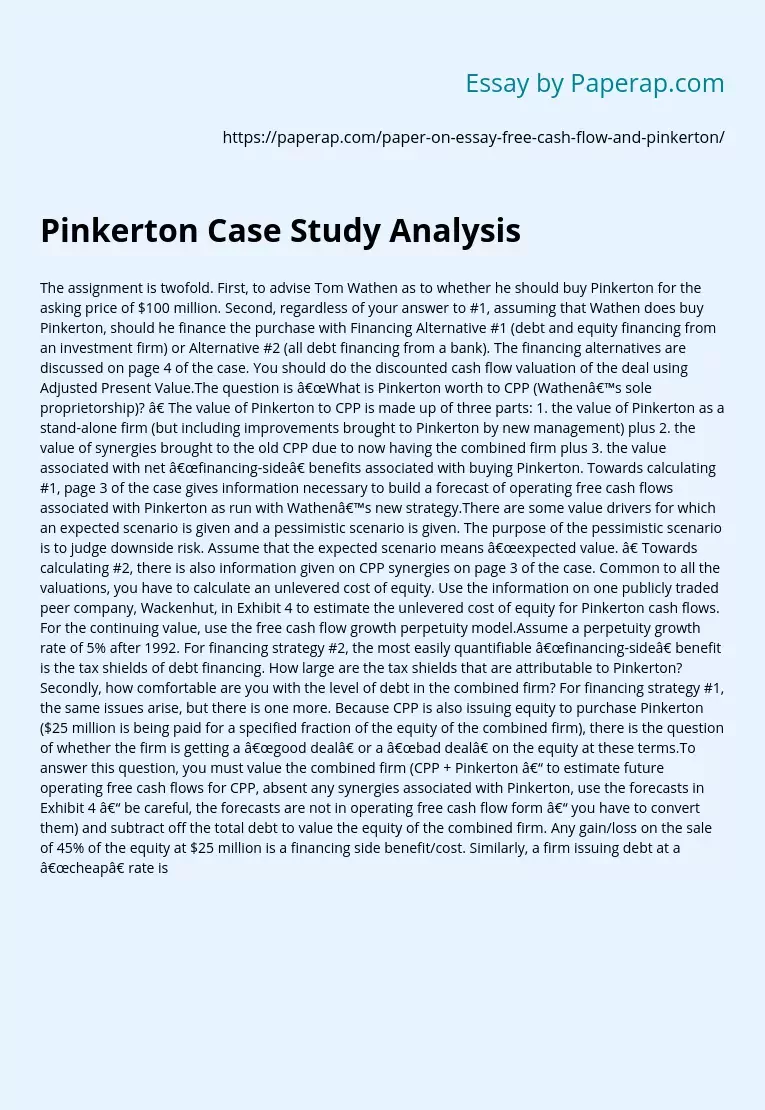Pinkerton Case Study Analysis
The assignment is twofold. First, to advise Tom Wathen as to whether he should buy Pinkerton for the asking price of $100 million. Second, regardless of your answer to #1, assuming that Wathen does buy Pinkerton, should he finance the purchase with Financing Alternative #1 (debt and equity financing from an investment firm) or Alternative #2 (all debt financing from a bank). The financing alternatives are discussed on page 4 of the case. You should do the discounted cash flow valuation of the deal using Adjusted Present Value.
The question is “What is Pinkerton worth to CPP (Wathen’s sole proprietorship)? ” The value of Pinkerton to CPP is made up of three parts: 1. the value of Pinkerton as a stand-alone firm (but including improvements brought to Pinkerton by new management) plus 2. the value of synergies brought to the old CPP due to now having the combined firm plus 3. the value associated with net “financing-side” benefits associated with buying Pinkerton. Towards calculating #1, page 3 of the case gives information necessary to build a forecast of operating free cash flows associated with Pinkerton as run with Wathen’s new strategy.
There are some value drivers for which an expected scenario is given and a pessimistic scenario is given. The purpose of the pessimistic scenario is to judge downside risk. Assume that the expected scenario means “expected value. ” Towards calculating #2, there is also information given on CPP synergies on page 3 of the case. Common to all the valuations, you have to calculate an unlevered cost of equity. Use the information on one publicly traded peer company, Wackenhut, in Exhibit 4 to estimate the unlevered cost of equity for Pinkerton cash flows.
For the continuing value, use the free cash flow growth perpetuity model.Assume a perpetuity growth rate of 5% after 1992. For financing strategy #2, the most easily quantifiable “financing-side” benefit is the tax shields of debt financing. How large are the tax shields that are attributable to Pinkerton? Secondly, how comfortable are you with the level of debt in the combined firm? For financing strategy #1, the same issues arise, but there is one more. Because CPP is also issuing equity to purchase Pinkerton ($25 million is being paid for a specified fraction of the equity of the combined firm), there is the question of whether the firm is getting a “good deal” or a “bad deal” on the equity at these terms.To answer this question, you must value the combined firm (CPP + Pinkerton – to estimate future operating free cash flows for CPP, absent any synergies associated with Pinkerton, use the forecasts in Exhibit 4 – be careful, the forecasts are not in operating free cash flow form – you have to convert them) and subtract off the total debt to value the equity of the combined firm. Any gain/loss on the sale of 45% of the equity at $25 million is a financing side benefit/cost. Similarly, a firm issuing debt at a “cheap” rate is a financing side benefit also.
Essay Example on Freakonomics Summary Chapter 3
Pinkerton Case Study Analysis. (2019, Nov 27). Retrieved from https://paperap.com/paper-on-essay-free-cash-flow-and-pinkerton/

